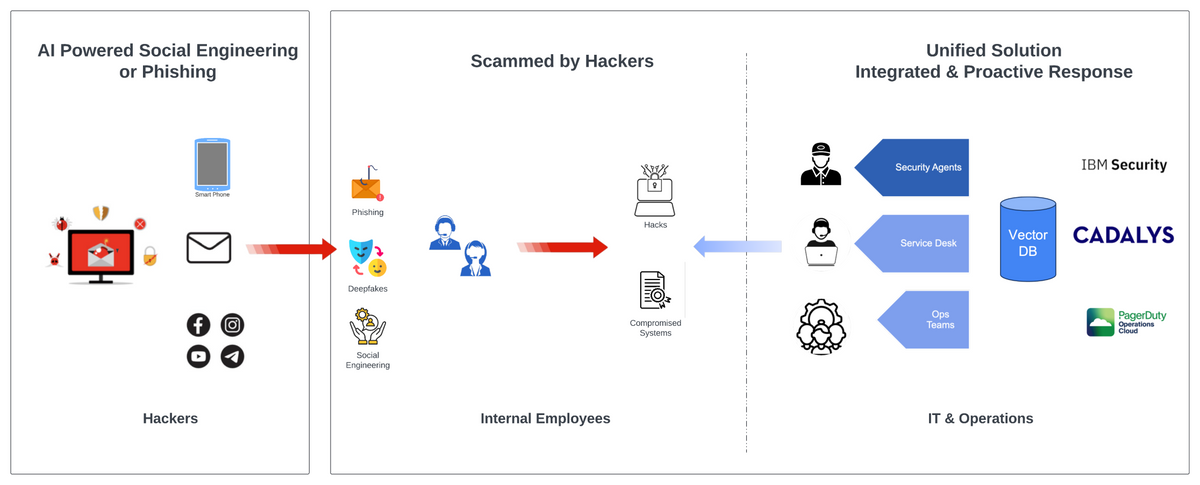As the world of cybersecurity collides with rapid technological advancements, Artificial Intelligence (AI) stands at the crossroads. It is both a groundbreaking defense mechanism against cyber threats and a powerful tool in the hands of malicious actors. The rise of AI-powered cyberattacks presents an evolving challenge that will overwhelm unprepared organizations. Companies like IBM, Cadalys, and PagerDuty are already at the forefront, preparing businesses to withstand this coming storm.
The Evolving Threat to Digital Security
In 2023, we saw an alarming 72% increase in global data breaches compared to the previous year, a trend that's only accelerating. With the growing influence of Generative AI (GenAI), 2024 is set to shatter previous records for cyber intrusions. The stakes are high: companies not only face devastating financial losses and operational disruptions but also long-lasting reputational damage that is difficult to recover from. The threat landscape now extends beyond corporate data to personal employee data, making cybersecurity a critical factor in retaining both customer trust and workforce stability.
Cybercriminals are leveraging AI to outpace organizations by exploiting sophisticated techniques. These range from social engineering and automated phishing to deepfakes and data poisoning, exposing vulnerabilities in unprepared organizations.
AI-Powered Social Engineering: The Next Frontier
Social engineering, long a cornerstone of cybercrime, has been supercharged by AI. These attacks trick individuals into revealing sensitive information by using psychological manipulation. With AI, hackers can now test, refine, and deploy highly personalized attacks at scale. This creates a dangerous scenario where even the savviest employees may fall victim to a convincingly crafted message, automated to perfection.
Automated Phishing Attacks: Hyper-Personalized and Scalable
Phishing attacks, once recognizable through poor grammar and generic content, are evolving. With the power of GenAI, hackers can craft highly personalized and convincing phishing emails, fooling employees into divulging confidential information or clicking malicious links. AI also enables hackers to cross-reference data from multiple platforms, amplifying the damage of a single breach. The level of precision in these attacks leaves organizations scrambling to keep up.
Deepfakes: Crossing the Line Between Fiction and Reality
Deepfakes have moved from a novelty to a dangerous tool for cybercriminals. AI-generated videos that mimic real people, including colleagues or company executives, are now being used to manipulate employees into taking unauthorized actions. One striking example is a finance employee at a multinational firm who was tricked into transferring $25 million after attending a virtual meeting filled with AI-powered deepfake attendees, including a convincing deepfake of the company CFO.
AI Exploits Through the API Attack Vector
In 2023, hackers infiltrated a major cellphone carrier customer database via an AI-enabled attack on its API, exposing the personal data of 37 million customers. This breach is expected to cost the company around $175 million in tangible damages, not including the long-term revenue losses from the damaged customer trust. As more organizations rely on APIs for operations, they become an increasingly attractive target for sophisticated AI-driven exploits.
Mitigating AI-Enabled Threats: Preparing for Battle
As AI continues to evolve, so too must our approach to defending against it. How is your organization positioned to handle the next wave of AI-driven cyberattacks? More importantly, how can you ensure that your defenses keep pace with the rapidly changing threat landscape?
De-risk and Defend: A Unified Solution
IBM, Cadalys, and PagerDuty have come together to create a comprehensive, integrated solution designed to defend against evolving AI-driven threats. The solution offers organizations a multi-layered approach, combining advanced threat detection, real-time event management, orchestration, automation, and robust analytics. This powerful solution allows businesses to proactively gather threat intelligence, streamline incident response, and minimize the impact of attacks. By leveraging automation and advanced ITSM and Enterprise Service Management workflows, companies can significantly reduce downtime and safeguard their critical assets and data.
Through dynamic playbooks and incident automation, organizations can expect to respond seven times faster to issues, resolve security incidents up to 85% more quickly, and maintain compliance with global data protection regulations such as GDPR, HIPAA, and CCPA.


